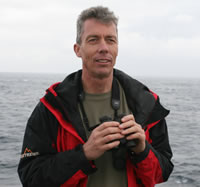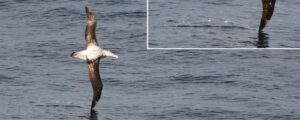 By Peter Ryan, onboard scientist, expert in general ornithology, seabird-fishery interactions, evolutionary ecology, marine debris, solid waste management, biology of oceanic islands.
By Peter Ryan, onboard scientist, expert in general ornithology, seabird-fishery interactions, evolutionary ecology, marine debris, solid waste management, biology of oceanic islands.
Leg 2, Day 1.
Welcome to all the leg 2 newbies. This blog summarises each day’s sightings. By departing Hobart at midnight, we missed all the coastal seabirds, awaking to deep-water pelagic species that typically only return to land to breed. Despite traversing similar waters on our route north a few days ago, we saw three new species: Cook’s Petrel (at the western edge of its range), Little Shearwater and White-faced Storm Petrel. Proportions of the commoner species also changed (e.g. Gould’s Petrel replaced White-headed as the most abundant Pterodroma).
| Fairy Prion | 82 | Short-tailed Shearwater | 39 |
| Gould’s Petrel | 29 | Shy Albatross | 18 |
| Little Shearwater | 12 | White-chinned Petrel | 11 |
| Mottled Petrel | 11 | White-faced Storm Petrel | 11 |
| White-headed Petrel | 5 | Wandering Albatross | 3 |
| Black-browed Albatross | 3 | Cook’s Petrel | 2 |
| Southern Royal Albatross | 1 | Sooty Shearwater | 1 |
| Brown Skua | 1 | Black-bellied Storm Petrel | + |
On the marine mammal front, we passed four fur seals (presumably Australian Fur Seals) before breakfast, and had a nice pod of Long-finned Pilot Whales just after lunch. Guiseppe saw two small sharks during his dedicated litter transects, which focus on the first 20 m from the boat’s track. No litter was seen, but there were several large jellyfish that resembled submerged litter items. Bull Kelps were fairly common throughout the day, with many carrying large loads of goose barnacles Lepas. The evening’s neuston net caught a piece of kelp with a goose barnacle attached, as well as several fish and a Portuguese Man-of-War (a colonial jellyfish). Surface water samples were clean relative to those collected before reaching Hobart, but all contained microfibers and a few small plastic fragments.
